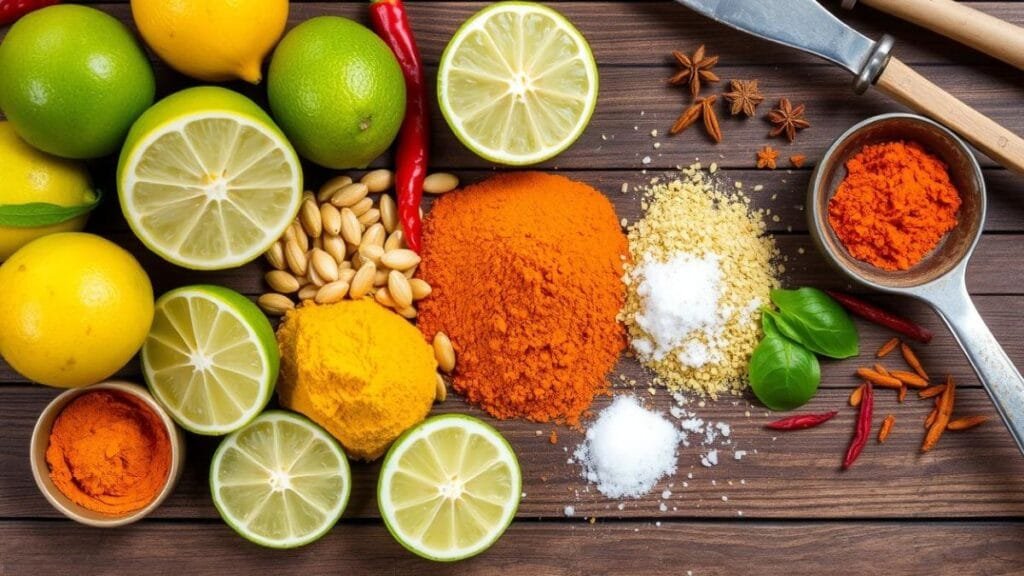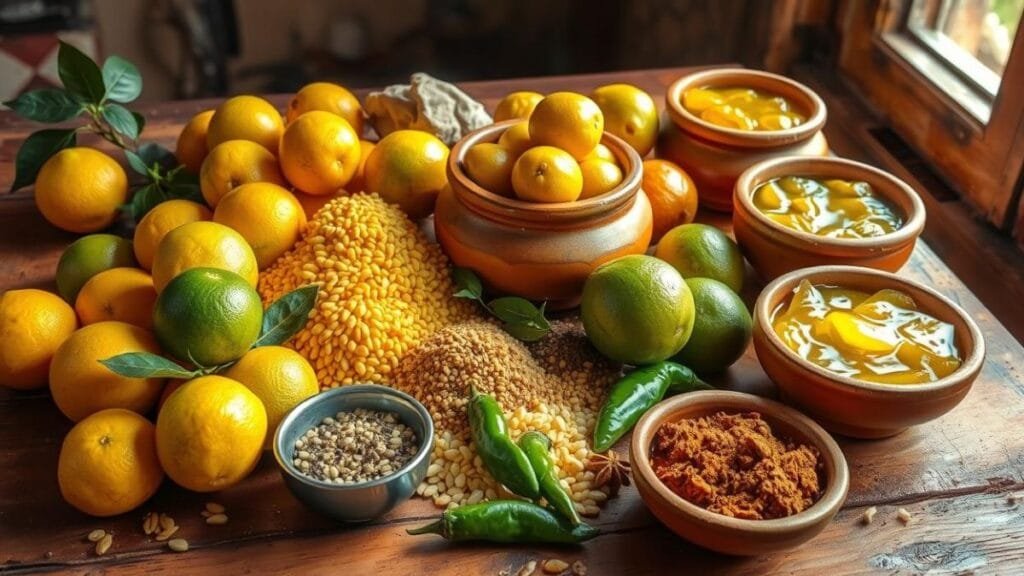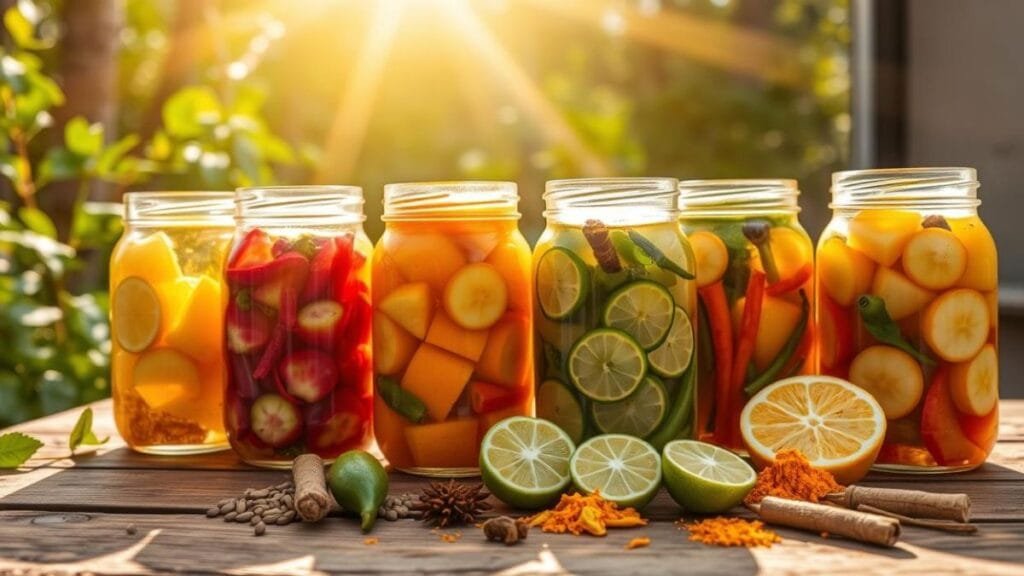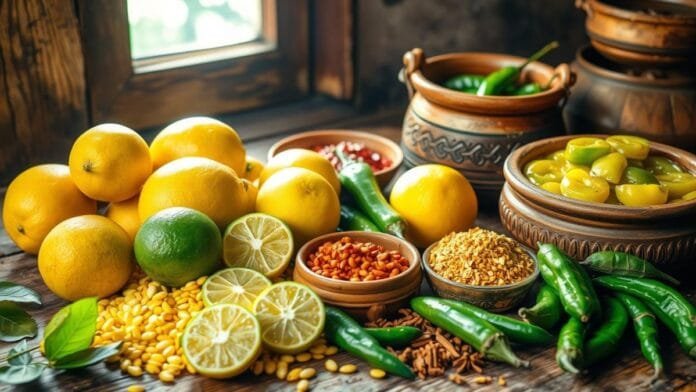Did you know that traditional Indian homes often have 3-4 different pickle varieties? Indian pickling recipes with lime no oil are a centuries-old tradition. They turn simple citrus fruits into vibrant, flavorful condiments.
I’ve found that oil-free Indian pickles are more than just a way to preserve food. They are a rich cultural art form. These pickles are tangy, nutritious, and show the versatility of traditional cooking.
Indian vegan pickles have been a household staple for generations. Each family has its own unique recipe, passed down through the years. Making these pickles involves choosing the right spices, using the right amount of salt, and letting them ferment in the sun.
This guide will take you into the world of traditional Indian pickle-making. We’ll focus on no-oil lime pickle techniques that bring out amazing flavors while keeping them nutritious. We’ll cover everything from picking the perfect limes to understanding the fermentation process.
- The Art of Oil-Free Indian Pickling
- Essential Ingredients for Indian Pickling Recipes with Lime No Oil
- Selecting and Preparing the Perfect Limes for Pickling
- Traditional Spice Blends and Their Role
- Step-by-Step Sun Fermentation Process
- Storage and Preservation Tips
- Serving Suggestions and Culinary Uses
- Conclusion
The Art of Oil-Free Indian Pickling
Indian preserved foods have a long history of sun fermentation. This method turns simple ingredients into tangy side dishes. It’s a way to connect generations through flavor and technique.
Pickling in India is more than just preserving food. It’s a culinary art that captures regional flavors. This is done through careful preparation and natural techniques.
History of Sun-Fermented Pickles
Sun fermentation has been around for centuries in Indian homes. It involves preparing ingredients and using sunlight to create unique flavors.
- Originated in rural agricultural communities
- Developed as a method to preserve seasonal produce
- Passed down through generational cooking traditions
Benefits of Oil-Free Preservation
Oil-free pickling is healthier and keeps the authentic taste. It cuts down on calories and lets natural flavors stand out.
| Preservation Method | Calories | Flavor Intensity |
|---|---|---|
| Traditional Oil Pickling | High | Moderate |
| Sun Fermentation | Low | Intense |
Traditional vs Modern Pickling Methods
Traditional methods use sunlight and patience, while modern ones are quicker. Sun fermentation takes 2-3 weeks. It creates deeper flavors than rapid cooking methods.
- Traditional sun exposure: 4-5 days
- Natural salt curing process
- Minimal ingredient manipulation
The art of oil-free Indian pickling is evolving. It combines old techniques with new culinary ideas.
Essential Ingredients for Indian Pickling Recipes with Lime No Oil
Making the perfect lime achaar needs a mix of ingredients that turn simple limes into a vibrant Indian condiment. The art of making a traditional lemon pickle begins with picking the right parts. These parts will grow deep, complex flavors as they sun-ferment.
The main ingredients for a real lime achaar are:
- Fresh, juicy limes with thin skins
- Kala namak (Indian black salt)
- Granulated sugar
- Variety of aromatic spices
For a great lemon pickle, I use a special spice mix:
- Turmeric powder (3 teaspoons)
- Red chili powder (4 tablespoons)
- Black peppercorns
- Asafoetida (1/2 teaspoon)
- Mustard seeds (1 teaspoon)
- Fenugreek seeds (1 tablespoon whole)
To add more flavor, I suggest a few extra ingredients:
- Green Thai chilis (15-30, depending on heat preference)
- Julienned ginger (3/4 cup)
- Fresh lime juice
The key to a top-notch Indian condiment is the right mix of ingredients. With the right selection and prep, you’ll make a lime achaar that truly captures the spirit of Indian pickling.

Selecting and Preparing the Perfect Limes for Pickling
Making tasty pickle recipes starts with picking the right citrus fruits. The key to great Indian pickles is using lemons or limes with thin skins. These fruits give the best flavor and texture.
When making traditional Indian pickles, picking the right fruits is key. Here’s how to choose and prepare them.
Choosing the Right Citrus Fruits
Look for limes that are:
- Bright, vibrant green color
- Firm texture without soft spots
- Smooth, thin skins ideal for absorbing spices
- Medium size (approximately 2-3 inches long)
Proper Cleaning and Drying Techniques
Good preparation is essential for safe and tasty pickles. Here’s how to clean them:
- Rinse limes under cool running water
- Gently scrub with a soft vegetable brush
- Pat completely dry with a clean kitchen towel
- Allow air drying for an additional 30 minutes
Cutting and Preparation Methods
For the best pickling, cut limes into consistent pieces:
- Quarter limes for traditional styles
- Remove seeds to prevent bitterness
- Aim for bite-sized pieces around 1/2 inch in size
- Ensure uniform cutting for even fermentation
Traditional Indian pickling uses about 6 limes per batch. This mix creates a perfect flavor balance for home use.
Traditional Spice Blends and Their Role
In the world of Indian pickles, spice blends are key to flavor. Exploring traditional pickling shows a complex mix of tastes. This mix turns simple ingredients into culinary wonders.
The art of making the perfect spice mix for pickles is a tradition passed down through generations. It’s a blend of carefully chosen spices that add flavor and help preserve the pickles.
Red chilli powder is important for adding depth and heat. Other spices work together to create a balanced flavor.
- Ajwain (carom seeds) for digestive properties
- Black peppercorns for sharp flavor
- Fenugreek seeds for earthiness
- Asafoetida for unique aromatic notes
Toasting and grinding spices like fenugreek and mustard seeds can really boost flavor. Dry roasting releases oils, making the taste more intense and complex.
| Spice | Flavor Profile | Preservation Role |
|---|---|---|
| Red Chilli Powder | Intense Heat | Antibacterial Properties |
| Fenugreek Seeds | Nutty, Bitter | Prevents Spoilage |
| Mustard Seeds | Sharp, Pungent | Natural Preservative |
The balance of spices turns simple preservation into an art form. It captures the essence of Indian culinary tradition. Each blend shares a story of regional expertise and generational knowledge.
Step-by-Step Sun Fermentation Process
Making a perfect lime pickle at home needs patience and the right steps. The sun fermentation turns simple ingredients into a tangy, flavorful condiment. You can store it in glass jars for months.
Let’s explore how to make an authentic Indian lime pickle through sun fermentation.
Initial Salt Treatment
The journey starts with careful preparation. Here are the key ingredients you’ll need:
- 2 pounds of fresh limes (about 18 limes)
- 4 tablespoons of sea salt
- 3 tablespoons of turmeric powder
- 1 tablespoon of white vinegar
Spice Addition Timeline
Adding spices at the right time is key for deep flavors. Here’s how to do it:
- First spice mix: Mix mustard seeds, fenugreek, and asafoetida
- Day 2-3: Add cayenne pepper (2-3 tablespoons)
- Day 4-5: Add more ground spices
Monitoring Fermentation Progress
It’s important to track your pickle’s progress. Use this guide to keep track:
| Fermentation Stage | Duration | Expected Changes |
|---|---|---|
| Initial Fermentation | 4 weeks | Lime skins soften, liquid thickens |
| Resting Period | 2+ weeks | Flavors deepen, texture improves |
| Final Storage | Up to 4 years | Maintained potency in refrigeration |
Pro tip: Use clean, sterilized glass jars and keep them in direct sunlight. Shake the jars 1-2 times daily for even fermentation. Your homemade pickle will have rich, complex flavors that store-bought can’t match!

Storage and Preservation Tips
Once your pickle is ready, keeping it fresh is key. I’ll share tips to keep your homemade lime pickle tasty for months.
Here are the main steps to preserve your pickle:
- Always use a dry spoon when serving to prevent moisture contamination
- Store in a cool, dark place at room temperature
- Use an airtight glass container for optimal preservation
- Shake the jar periodically to distribute spices and prevent fungal growth
How long your pickle lasts depends on storage. It can stay good for up to 6 months. Keeping it clean and dry is essential.
| Storage Condition | Expected Shelf Life |
|---|---|
| Room Temperature | 6 months |
| Refrigerated | 1 month |
If you want to jump to recipe details or check preparation methods, refer to previous sections. The key is maintaining a dry environment and using clean utensils every time you serve your delicious pickle.
Pro tip: As the pickle ages, it might darken slightly, which is normal and doesn’t indicate spoilage. Always trust your senses – if it smells off or looks unusual, it’s best to discard it.
Serving Suggestions and Culinary Uses
Lime chutney is a key part of Indian cuisine, adding a burst of tangy flavor. It turns simple meals into something special. I’ve found many ways to use this zesty condiment in everyday cooking.
Traditional Pairings
In true Indian meals, lime chutney is more than a side dish. It goes great with:
- Hot steamed dal and rice
- Freshly made parathas
- Comforting khichdi
- Grilled vegetable platters
Modern Serving Ideas
Today, lime chutney is used in new ways. Try it as:
- A sandwich spread
- A marinade for grilled meats
- A flavor booster for salad dressings
- A dipping sauce for appetizers
Health Benefits and Considerations
Lime chutney is not just tasty; it may also help your digestion. The fermentation adds probiotics, good for your gut. But, it’s high in salt, so eat it in moderation.
Research shows it’s best to use about 1-2 tablespoons per meal. This way, you get the flavor without too much salt.

Conclusion
Exploring Indian pickling recipes with lime no oil has shown me a deep culinary tradition. These lime pickles are more than just a condiment. They connect us to generations of kitchen wisdom, passed down through families in India.
The ways to make Indian lime pickles are amazing. You can use sun fermentation that takes 3-4 days or quicker stovetop methods. Home cooks can make flavorful preserves that last up to a year. It’s all about precision: balancing salt, choosing the right limes, and mastering fermentation.
Learning these traditional recipes has taught me that pickling is both a science and an art. It requires patience. Letting natural processes turn simple ingredients into tangy delicacies. Each lime pickle has a story of cultural heritage and culinary innovation.
If you love preserving traditional cooking, try Indian lime pickles. With practice, you can make these delicious, gut-friendly condiments. They not only make meals better but also connect us to a rich culinary tradition.
Frequently Asked Questions
How long can I store homemade oil-free lime pickle?
Homemade oil-free lime pickle can last months to a year at room temperature. Use sterilized glass jars and keep it cool and dark. Always use clean utensils to serve.
Do I need special equipment to make lime pickle at home?
You’ll need clean glass jars, a knife, cutting board, and sunlight. A muslin cloth helps with fermentation. Common spices and limes are all you need.
Is sun fermentation really necessary for making lime pickle?
Sun fermentation adds flavor but isn’t required. If sunlight is scarce, use stovetop or oven. Sunlight gives the best taste and preservation.
Can I make this pickle if I live in a cooler climate?
Yes, you can make lime pickle in cooler climates. Use a warm spot or oven fermentation. A warm, dry place is key for fermentation.
Are oil-free lime pickles healthier than traditional oil-based pickles?
Oil-free lime pickles are healthier with fewer calories. They let natural flavors shine. They’re great for those watching fat intake but wanting Indian flavors.
How often should I shake the pickle jars during fermentation?
Shake jars 1-2 times daily. This spreads spices and prevents mold. Be gentle to avoid damaging limes.
Can I adjust the spice level in the pickle?
Yes! Adjust the heat with red chili powder or green Thai chilis. Start with a little spice and add more as you like.
What are the best ways to serve lime pickle?
Serve lime pickle with dal and rice, in parathas, or with khichdi. It’s also good on sandwiches, wraps, or as a topping for grilled foods.














